How to Create an App Like Uber: An Inside Look from the Design, Development, & Delivery Team
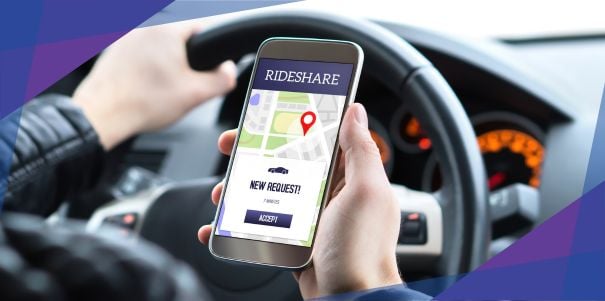
Disclaimer: Appetiser Apps has not worked with Uber, Dropbox, or Airbnb. All company names and examples are referenced for educational and illustrative purposes only.
Here’s a sobering statistic. Even established ride-sharing apps like Uber faced significant financial challenges. For instance, In 2024, its share price was still 22% below its 2019 opening price despite a post-pandemic recovery.
Yet the success stories – Lyft, Grab, and Didi – make it seem deceptively simple. What separates the successes from the failures?
What does it take to build a successful ride-sharing platform? After building mobile applications for clients across three continents, our app design, development, and delivery teams have identified patterns that most “how-to” guides miss entirely.
Let’s uncover the secrets behind creating a thriving Uber-like app. You’re in for a good treat as there are insights from our teams sharing their experiences and thoughts.
Create an Uber-like app in 8 steps
- Map your success: Revenue and business model
- Look under the hood: Inside an Uber-like app’s architecture
- Plan your route: Starting with MVP features
- Pick your engine: Choosing the right tech stack
- Design your dashboard: Creating an intuitive user experience
- Assemble your crew: Development process and team collaboration
- Road test your ride: Testing and quality assurance
- Hit the road: Launch strategy and beyond
1. Map your success: Revenue and business model
When developing an app like Uber, selecting the right monetization model is crucial. As Brian Wong, one of our product managers, said:
![]()
To choose a monetization strategy that works for your platform, you really need to do research. You need to understand your competitors, how your users are currently solving the problem, what they’re paying for, and how much they’re willing to pay.

Brian Wong
Product Manager
First up, let’s look at the commission-based model. Uber and Lyft were reported to snag about 20% to 30% from commission during the worst of the pandemic. But here’s the catch: these rates aren’t set in stone and can fluctuate based on market conditions.
There’s also dynamic pricing also known as surge pricing. This nifty strategy adjusts rates based on factors like time, distance, traffic, and real-time demand. It’s all about striking that perfect balance between supply and demand while giving drivers a little extra incentive during those crazy peak hours.
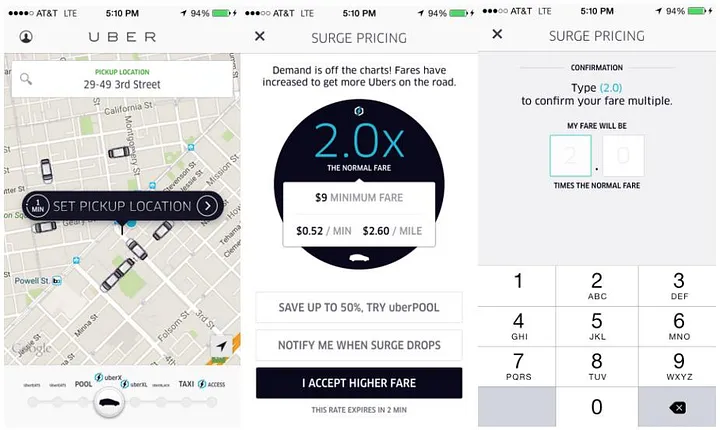
Image credit: ReneeLIN | Medium
Diversifying revenue streams is also important. Uber has got its hands in everything from mobile advertising to corporate accounts and even food delivery with Uber Eats. And let’s not forget about those driver incentives – bonuses and rewards programs like Uber Pro keep the drivers happy and on the road.
This video actually unpacks how Uber makes money. It’s worth watching if you want to go deeper into the business model.
Source: HTM | YouTube
For loyal users, Uber has subscription-based programs like Uber One — more perks, more benefits, more reasons to keep using the app.
The key takeaway? Do your research, crunch those numbers, and don’t be afraid to mix things up. With the right app monetization strategies in place, you can serve your customers better with a sustainable business model that works for you.
But a killer monetization plan is just the beginning. To really rev up your ride-sharing app, you need to peek under the hood and understand what makes it tick.
2. Look under the hood: Inside an Uber-like app’s architecture
A successful taxi booking app isn’t built in a garage overnight. It’s crafted through careful attention to three core elements that most guides overlook:
- The rider app with push notifications
- The driver app with passenger tracking features and integrations
- The admin panel for operations management
Each plays an important role in creating a delightful booking experience.
1. The rider’s app: The face of your service
The rider app is where your customers will interact with your service. It needs to be intuitive, fast, and reliable. Maku Montecer, Head of Delivery at Appetiser Apps, emphasizes the importance of user-friendliness.
![]()
If it takes more than five to eight clicks, something is wrong with the app, and we need to find a way to reduce that friction.

Maku Montecer
Head of Delivery
Key features of a rider app include:
- Stress-free, frictionless registration process
- Efficient booking system
- Real-time ride tracking
- Secure payment integration
- Rating and feedback mechanism
2. The driver’s app: Empowering your service providers
The driver app is the lifeline for your service providers. It must be simple yet powerful, allowing drivers to manage their work efficiently. Your app must be able to handle requests efficiently. Thus, building a native version is much better.
Adonis Dumadapat, an iOS Developer, stresses the importance of native app development:
![]()
Go native. Many people take the high-speed approach — developing once and compiling it into both Android and iOS. Yes, you save some money upfront, but in the end, you’ll definitely encounter problems.

Adonis Dumadapat
App Developer
Essential features of a driver app include:
- Easy onboarding process
- Trip management system
- Navigation integration
- Earnings tracker
- In-app communication with riders
3. The admin panel: The command center
The admin panel is where you’ll manage your entire operation. It needs to provide comprehensive control and insights into your whole business process.
For example, administrators can access critical metrics such as the number of rides, revenue generated, and user activity. This data helps in making informed business decisions and identifying trends.
The panel allows administrators to review and approve driver applications and suspend or deactivate user and driver accounts if necessary. This feature is essential for maintaining service quality and safety standards, ensuring the protection of both passengers and drivers.
Don’t overlook safety and legal workflows. Build features for incident reporting, insurance verifications, and post-crash support that route users to help fast.
In regions like New South Wales, clearly communicating the real-world consequences of risky driving – including potential NSW traffic fines and penalties for drivers who break road rules – helps riders and drivers understand what’s at stake and encourages safer behaviour.
Meanwhile, in U.S. cities like St. Louis, riders hurt in a rideshare collision often consult an Uber accident lawyer to understand fault, insurance tiers, and filing deadlines; designing clear in-app guidance and escalation paths reduces confusion and protects your brand.
Key functionalities for the admin panel include:
- User management (both riders and drivers)
- Trip monitoring and analytics
- Payment processing and reporting
- Customer support tools
- Marketing campaign management
Most founders want their app to do everything at launch. But Brian Wong, one of our product managers, offers a different perspective:
![]()
Clients often panic when entering tech. They focus too much on having everything rather than prioritizing what matters.

Brian Wong
Product Manager
The solution? Start with your core offerings, which will be discussed in the next section.
3. Plan your route: Starting with MVP features
Think of Twitter’s early days — they didn’t even have an edit button. Yet people use it because it solves their primary need: instantly sharing thoughts.
Your ride-sharing app needs the same focus. Before dreaming about AI-powered features like customer experience automation or blockchain integration, ask yourself: What’s the one problem we’re solving? Michael MacRae, our CEO and founder, puts it this way:
![]()
Most successful apps have traditionally helped users save time, reduce effort, add convenience, or connect with others. Even games solve problems associated with boredom, stress, and loneliness.

Michael MacRae
Founder
Here’s what you need to do: Define your core offering.
When building a passenger app, an Uber app or any app like Uber, focus on the basic features first. These typically include:
- User registration and profile creation
- Ride booking and cancellation
- Driver-rider matching
- Real-time location tracking
- Basic payment integration
You can always add more features to your Uber-like app in the future. But if you want to speed up the launch and test if your app is a product-market fit. This would be a great option because you won’t be bogged down with unnecessary features and high upfront costs.
Check out these MVP app examples that inspire you to take your brainstorming to the next level.
4. Pick your engine: Choosing the right tech stack
When seconds count, translation layers cost too much.
That’s why Uber built separate native apps for iOS and Android from day one. They started with Objective-C for iOS and Java for Android — languages that speak directly to each platform. Later, they switched to Swift and Kotlin as these modern languages emerged.
Avoid chasing trends in development, especially when choosing stacks and technology. Our seasoned iOS app developer wisely stated:
![]()
It’s not important to chase trends, especially in iOS development. Apple sometimes introduces things they later want to move away from, and they don’t want developers to rely on them. So, just because something is new doesn’t mean it’s worth adopting. Stick with something stable, something tested and used over time.

Adonis Dumadapat
App Developer
I couldn’t agree more.
Think about what happens when you request a ride. Your phone pinpoints your location, sends it to nearby drivers, updates their positions in real time, and processes payments. Each action must happen instantly.
Native development lets Uber tap directly into your phone’s GPS and Apple push notification service capabilities, and accelerometer without any middlemen slowing things down.
Source: YouTube
Could they have saved money by building one hybrid app instead of a native app? Sure. But Uber bet on app performance and reliability over short-term savings. When you’re processing millions of ride requests daily, even milliseconds matter.
Time proved them right. Today’s Uber app handles complex animations, precise location tracking, and seamless payments — all while feeling natural on both iOS and Android.
That’s the power of going native.
You can read more about the most loved and hated programming languages to help you decide which tech stack is best for you.
5. Design your dashboard: Create an intuitive user experience
![]()
UX is all about the journey — how smooth, fun, or frustrating it is to get from A to B. UI is the eye candy — what the buttons, screens, and visuals look like on that journey.

Calvin Cica
Product Designer
“UX is all about the journey — how smooth, fun, or frustrating it is to get from A to B. UI is the eye candy — what the buttons, screens, and visuals look like on that journey,” explains Calvin Cica, Product Designer at All X.
For a ride-sharing app, this couldn’t be more literal. Your users are literally going from A to B, and your app design determines how smoothly that happens.
Why your app design makes or breaks the app
When someone needs a ride, they’re often in a hurry. They might be:
- Running late for a meeting
- Catching a flight
- Heading home late at night
- Rushing to an important event
Your design needs to work as fast as they think. Every extra tap could mean a lost user. That’s why it’s a skill to make complex systems invisible. The reality is that:
Your ride-sharing app juggles countless operations:
- Finding the closest available drivers
- Calculating surge pricing in real-time
- Optimizing routes through traffic
- Processing secure payments
- Tracking driver and rider locations
But to your users? It should feel like magic. Open app. Tap button. Get ride.
Why you also need to strike the balance between UI/UX?
Think of your ride-sharing app like a duck swimming. Above water, everything looks smooth and effortless. Below? Feet paddling frantically.
That’s exactly how your app should work. Behind the scenes, complex algorithms match riders with drivers, calculate routes, and process payments. But users? They just see a simple “Request Ride” button.
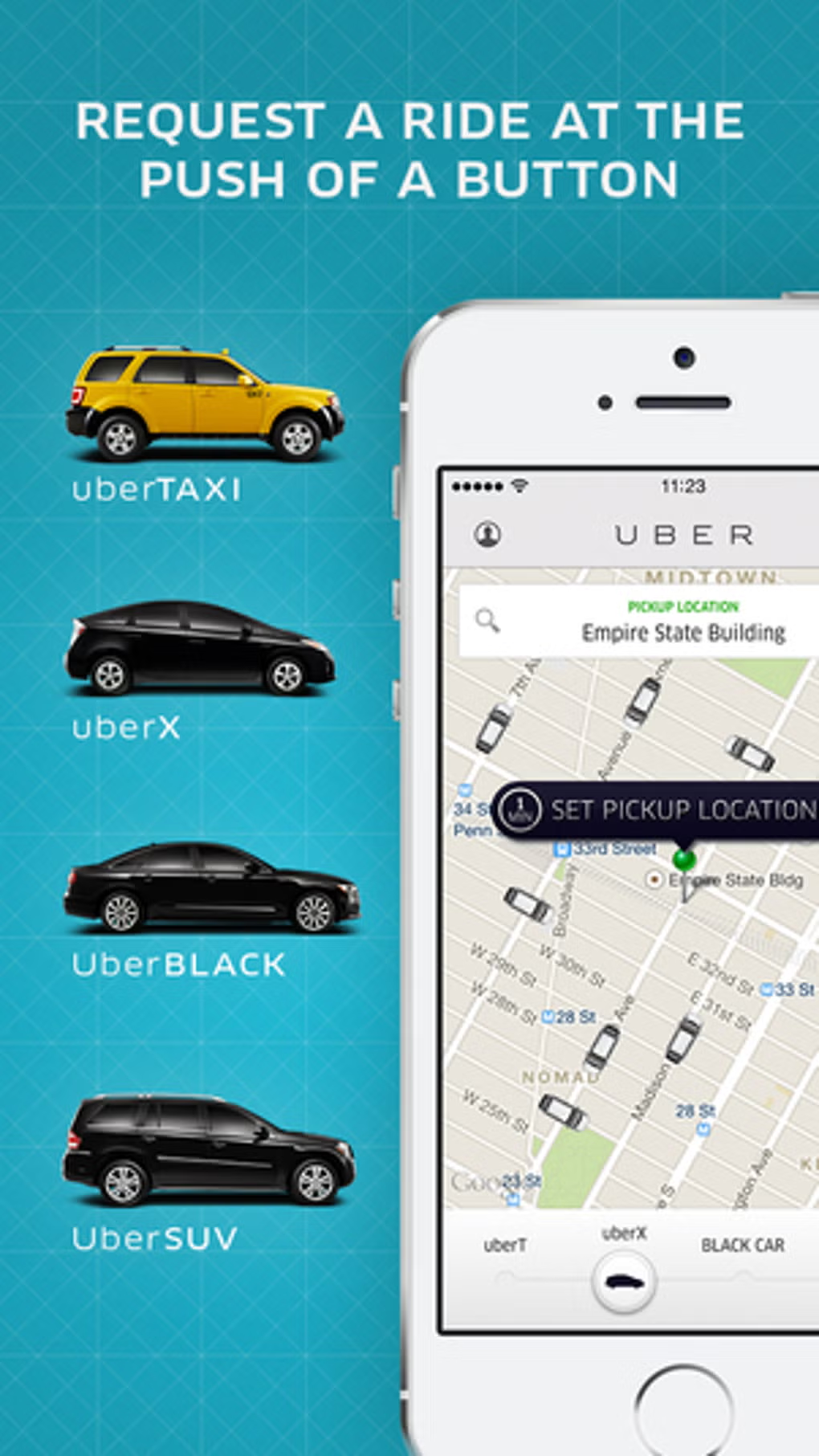
Image credit: Uber
Let’s break down how to achieve this balance:
- Keep it lightning fast. Your app might run sophisticated location tracking and pricing calculations, but users won’t appreciate the clever math if the app feels sluggish. Each screen should load instantly. Every animation should flow smoothly. Every tap should respond immediately.
- Hide the complexity. Remember, users don’t care about your brilliant matching algorithm or real-time route optimization. They care about getting from A to B. Strip away everything that doesn’t directly help them achieve this goal.
- Feature smart. Not every feature deserves prime screen real estate. Think about frequency: Daily use? Put it front and center. Weekly use? Tuck it in a menu. Rare use? Hide it in settings.
- Teach gradually. Don’t overwhelm new users with every feature at once. Start with basics like requesting rides. Once they’re comfortable, introduce advanced features like scheduled pickups or split payments. Think of it as teaching someone to drive — you don’t start with parallel parking.
- Speak one language. Your app should feel like one cohesive app experience. Buttons, colors, fonts, and interactions should stay consistent throughout. When users learn something on one screen, it should work the same way everywhere else.
The best technical solution is the one users never notice. They should focus on getting their ride, not figuring out your app.
I asked our Head of Delivery, Maku Montecer, how to ensure that the product is both technically sound and delightful to the users. His response is definitely practical and a great exercise during the app design and development process.
![]()
I usually let other people use the app to see how they interact with it. I’ll ask them, “If you see this, how would you use it?” If they don’t get it at first glance, then I know there’s something wrong with the UX.
Since I’ve been in app development for a while, everything makes sense to me, so I need that fresh perspective from regular users. That’s how I try to balance it. I also make a conscious effort to view the app from a different perspective because, when testing UX, you need to have the mindset of a normal user.

Maku Montecer
Head of Delivery
Maku’s insights underscore the importance of user testing and adopting a user-centric mindset throughout the development process. But creating a seamless user experience is just one piece of the puzzle. This brings me to my next point. Your dream team.
6. Assemble your crew: Development process and team collaboration
The development process for taxi app development requires careful planning. Whether you’re creating a basic Uber-like app or a full-featured, taxi booking app, start with core functionalities.
The key secret to getting things done faster? Start with great teams working together.
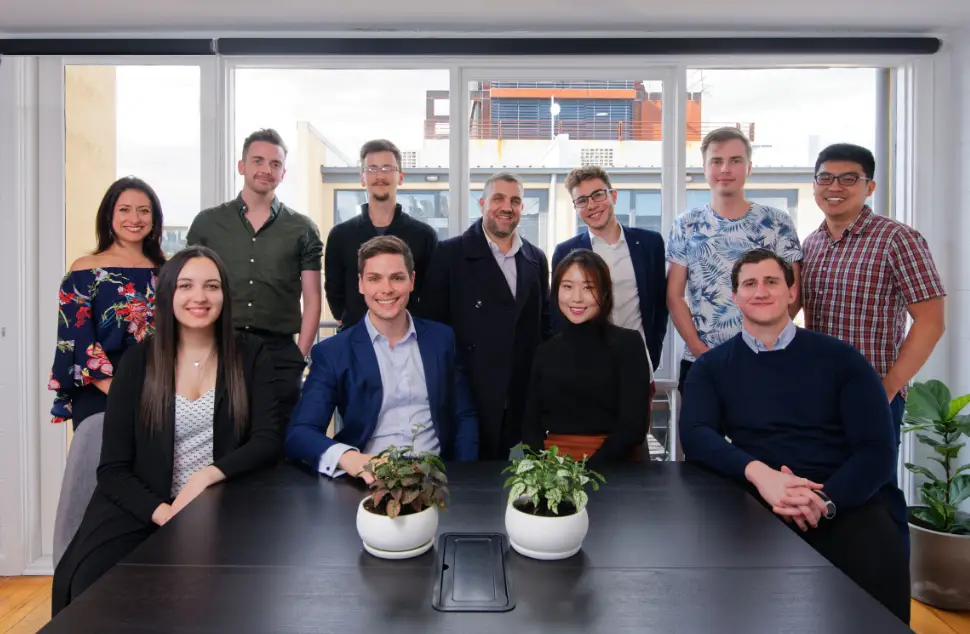
At the heart of successful app development lies a dance between different specialists, each bringing their own expertise to the table. They work in quick, repeated cycles — app testing, learning, and improving as they go.
“You need to collaborate with all stakeholders—designers, clients, and engineers—to figure out what’s actually needed,” says Brian Wong, a Product Manager who knows the value of getting everyone involved.
What makes this work? Teams meet often, share what they know, and use tools that help them stay connected. Engineers learn from designers. Designers learn from clients. Everyone grows together.
Here at Appetiser Apps, we also do things differently to achieve maximum speed and efficiency. That’s where Appetiser’s Baseplate™ technology comes in.
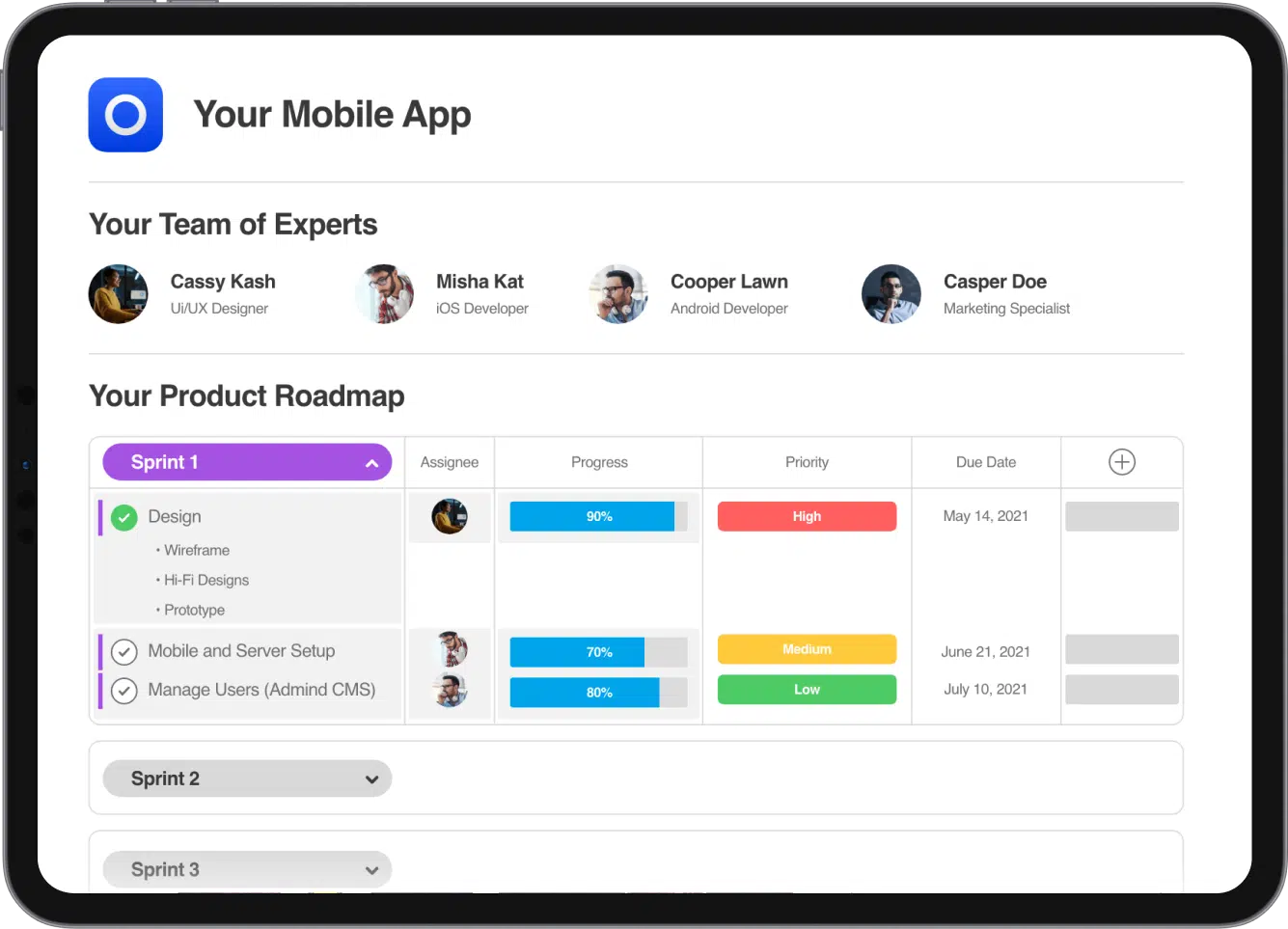
Think of it as a master chef’s prep kitchen. The basic ingredients and tools are ready to go. Teams don’t waste time recreating common features. Instead, they focus on what makes your app special.
Baseplate™ gives teams tested components and clear guidelines. It’s like having a head start in a race. You begin with proven solutions and spend your energy on innovation instead of reinventing wheels.
This framework provides:
- Pre-built components and modules tailored for on-demand apps
- Standardized architecture and best practices
- Reduced development time and costs
- Consistent quality across projects
The result? A faster path from idea to working app, with less waste and more consistency. Because in today’s world, getting to market quickly matters — but getting there with quality matters even more.
7. Road test your ride: Testing and quality assurance
Great apps don’t just happen. They’re tested, broken, fixed, and polished until they shine.
Think of testing like a dress rehearsal before opening night. Your app needs to nail its performance when real users arrive, not just in perfect conditions, but in the messy, unpredictable real world where internet connections fail and users do unexpected things.
But how do you test smart?
- Let machines handle the repetitive work. Automated tests can check thousands of scenarios in minutes, catching issues while developers sleep. It’s like having a tireless quality inspector working 24/7. App developers use XCTest, Appium, Espresso and UI Automator to get things done swiftly.
- Make humans useful. Real testers use the app like real people would, tapping impatiently, trying weird combinations, doing things the developers never imagined. They break things so users won’t have to.
The final test? Load testing — pushing your app to its limits. Can it handle hundreds of users searching for rides at once? Will it stay responsive during rush hour? These stress tests reveal whether your app can handle success when it comes.
But the most valuable feedback often comes from beta testers. These are early users who try your app in their daily lives. They’ll use it in ways you never expected and find issues you never anticipated. Their real-world experiences are worth their weight in gold.
Every bug caught in testing is a frustrated user you’ll never have to apologize to. And even if you do in the future, it will be less apologies because you caught them early on.
Here’s a comprehensive guide on mobile accessibility testing to give you more context on how it’s done.
8. Hit the road: Launch strategy and beyond for progress
Every app has a story of how it meets the world. Here’s how to make yours count.
![]()
There’s no such thing as a perfect app. There will always be issues, things that break, and odd things that users encounter. But as long as you protect your core concept and ensure that what you want to test works, that’s what matters.

Maku Montecer
Head of Delivery
Maku hits on a truth many founders miss: perfection isn’t the goal. You can launch speedily while protecting your core concept — the essential promise your app makes to users. Everything else is polished. You can add later.
So how do you launch smart?
- Start with the app stores. This is your digital storefront. Create listings that grab attention and explain your value clearly. Show, don’t tell, with screenshots that highlight your best features. And yes, follow those app store guidelines carefully. A rejected app can’t help anyone.
- Then spread the word. Get your early users excited enough to tell friends. Make sharing rewarding with a referral program as part of your mobile user acquisition strategy that benefits both sides. Partner with local businesses who share your vision — they might become your biggest champions.
But the real work begins after launch. Watch how people actually use your app, not how you think they should. Which features do they love? Where do they get stuck? Let real usage guide your improvements.
The best apps evolve with their users. They start good enough to be useful and grow into something great. Your job isn’t to launch a perfect app. It’s to launch one that solves real problems for real people and then make it better every day.
Here’s a good read on what to do before and post-launch of your mobile app.
Building an Uber-like app that users will use
Creating a ride-sharing app isn’t just about code and features. It’s about understanding your market, protecting your core concept, and building something that genuinely helps people get from A to B.
The way you can birth your dream app comes from starting small, testing thoroughly, and growing with your users.
Remember: even Uber wasn’t built in a day. Focus on solving real problems for real people, and let your app evolve based on actual user needs.
With our Baseplate™ technology and experienced cross-functional teams, our experienced app developers at Appetiser Apps can accelerate your journey from app idea to launch. Our approach combines battle-tested components with fresh innovation, helping you build faster without compromising quality.
We’ve helped clients across three continents launch successful apps, and we understand what separates winners from the rest in the ride-sharing space.
Whether you’re just starting out or looking to improve an existing platform, we’re ready to put that expertise to work for you. Book a call now with one of our product strategists, and make this your day 1 to fulfill your dream.

Maria Krisette Lim is a Content Marketing Specialist with 14 years of experience producing web and print ad content. Krisette has a BSBA degree, major in Business Management and Entrepreneurship. When she’s not tinkering with words and punctuation, she’s either curled up with a book while sipping hot tea, playing with her toddler, or tinkering with website builders.


